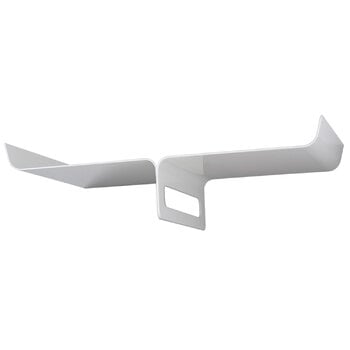The Kite hat rack, designed by Asshoff & Brogård for Maze, is a playful and lightweight storage solution for your entryway. The sleek metal shelf helps you keep scarves, hats and gloves in order while hangers and hooks can be placed on the bar below. Due to its airy look and small size, Kite is ideal for smaller spaces. The Kite hat rack is made in Sweden.
Kite hat rack, white
Maze
Description
The Kite hat rack, designed by Asshoff & Brogård for Maze, is a playful and lightweight storage solution for your entryway. The sleek metal shelf helps you keep scarves, hats and gloves in order while hangers and hooks can be placed on the bar below. Due to its airy look and small size, Kite is ideal for smaller spaces. The Kite hat rack is made in Sweden.
Product details (5)
- Colour
- White
- Width
- 45 cm
- Depth
- 25 cm
- Height
- 12 cm
- Material
- Powder coated metal
- Product ID
Designer
Asshof & Brogård is a design studio in Stockholm run by Johanna Asshof and Hanna Brogård. The young designers met while studying furniture- and product design in Stockholm. Asshof & Brogård want their design to be in prominent places, attracting smiles and raising eyebrows.
View all productsReviews (0)
Sustainability
The Product Sustainability Framework, our criteria of sustainable design, helps you find the most sustainable products in our selection. Read below which sustainability criteria this product has met.
Working conditions & labour 6/9
-
Equal opportunities for all employees
-
Commitment to UN Global Compact, fair compensation for all employees
-
Corporate responsibility requirements defined and communicated for suppliers
-
Systematic work for improved inclusion and well-being in the workplace
-
Transparent supply chain
-
Suppliers' compliance to a code of conduct ensured
-
Direct suppliers audited and certified
-
Compliance to the UN Guiding Principles on Business and Human Rights ensured in the supply chain
-
Support for community involvement in the supply chain
Eco-friendly production 7/9
-
Fair and resource-wise water-use in production
-
No incineration or landfilling of returned items
-
No use of endangered species as materials
-
No direct environmental emissions or waste (excl. GHGs) from production
-
The sustainability of direct suppliers' production is addressed and monitored
-
Material-efficient and ecological packaging
-
No potentially harmful chemicals used in own production
-
Production and material sourcing that respect biodiversity, animal rights, and natural ecosystems
-
Positive impact on nature’s well-being through operations that regenerate natural ecosystems
Climate impact 3/8
-
Company's direct greenhouse gas emissions identified and commitment to reduction
-
Product's carbon impact identified and commitment to reduction
-
Guidance on energy- and eco-efficient use of the product
-
Contribution to climate initiatives beyond the brand’s direct operations
-
Low-carbon or compensated transportation
-
Carbon footprint of the product calculated and goals set to reduce it
-
100 % renewable energy in own production and operations
-
Carbon neutral or carbon negative product
Sustainable materials 5/6
-
Sustainable and long-lasting material choices
-
No harmful or hazardous substances
-
Responsible raw material sourcing and production
-
Materials suited for circularity: monomaterials, recyclable finishings, renewable or recycled contents etc.
-
Ecological materials: natural, biodegradable, recyclable or recycled contents
-
Outstanding materials in terms of innovativeness, responsibility, sustainability and circularity: local production or sourcing, 100 % recycled content, C2C-certification etc.
Circular design 4/5
-
High aesthetic quality promoting long-term use of the product
-
Technically durable product design and material choices
-
Design for enduring life-long quality
-
Design and support for product maintenance, repair and upgradability
-
Innovative circular design solutions: circular service system, resale platform, remanufacturing, collection of used products, etc.























